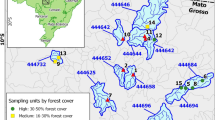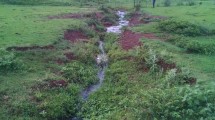Abstract
Headwater streams are important resources in production of organic matter, but zooplankton of headwater streams has rarely been studied. In the present study spatial changes in zooplankton communities between upper headwater forest section and downstream meadow section of four small streams were examined (NW Poland). The environmental conditions of stream riparian zone, e.g., the presence of leaf litter, pools, slackwaters and wetlands had a great influence on the spatial changes in zooplankton. Low gradient of stream bed, longer water residence time and larger surfaces of wetlands and slackwaters also positively affected zooplankton communities, especially in the meadow section. Along the streams, from the stream headwater to the downstream-meadow section, significant spatial changes in zooplankton communities were observed. Significantly higher number of taxa and density of zooplankton were observed in meadow sections than in headwater forest sections. In the forest sections, there was a definite domination of benthic and littoral rotifers in the zooplankton composition, while in the meadow sections, planktonic rotifers dominated. Cladocerans were observed only in downstream meadow section; two littoral species Coronatella rectangula and Peracantha truncata and one planktonic Daphnia magna which probably were washed from close pools of small stagnant water bodies. Copepods were noted along the entire length of streams. The occasional presence of planktonic rotifers in the forest section was probably caused by their washout from a few small stagnant water bodies.
Similar content being viewed by others
References
Allan J.D. 1998. Ekologia wód płynących [Stream Ecology. Structure and Function of Running Waters]. Wydawnictwo Naukowe PWN S.A., Warszawa, 450 pp. ISBN: 83-01-12535-7
Basu B.K. & Pick F.R. 1996. Factors regulating phytoplankton and zooplankton biomass in temperate rivers. Limnol. Oceanogr. 41(7): 1572–1577.
Baranyi C., Hein T., Holarek C., Keckeis S. & Schiemer F. 2002. Zooplankton biomass and community structure in a Danube river floodplain system: effects of hydrology. Freshwater Biol. 47(3): 473–482. DOI: 10.1046/j.1365-2427.2002.00822.x
Böhmer J., Zenker A., Ackermann B. & Kappus B. 2001. Macrozoobenthos communities and biocoenotic assessment of ecological status in relation to degree of human impact in small streams in southwest Germany. J. Aquat. Ecosyst. Stress Recov. 8(3/4): 407–419. DOI: 10.1023/A:1012987921434
Campbell C.E. 2002. Rainfall events and downstream drift of microcrustacean zooplankton in a Newfoundland boreal stream. Can. J. Zool. 80(6): 997–1003. DOI: 10.1139/Z02-077
Casper F.C. & Thorp J.H. 2007. Diel and lateral patterns of zooplankton distribution in the St. Lawrence River. River Res. Applic. 23(1): 73–85. DOI: 10.1002/rra.966
Cerbin S., Van Donk E. & Gulati R.D. 2007. The influence of Myriophyllum verticillatum and artificial plants on some life history parameters of Daphnia magna. Aquat. Ecol. 41(2): 263–271. DOI: 10.1007/s10452-007-9091-5
Chang K.H., Doi H., Imai H., Gunji F. & Nakano S.I. 2008. Longitudinal changes in zooplankton distribution below a reservoir outfall with reference to river planktivory. Limnology 9(2): 125–133. DOI: 10.1007/s10201-008-0244-6
Cummins K.W., Merrit R.W. & Andrade P.C.N. 2005. The use of invertebrate functional groups to characterize ecosystem attributes in selected streams and rivers in south Brazil. Stud. Neotrop. Fauna E. 40(1): 69–89. DOI: 10.1080/01650520400025720
Cummins K.W., Minshall W.G., Sedell J.R, Cushing C.E. & Petersen R.C. 1984. Stream ecosystem theory. Verh. Int. Verein. Limnol. 22: 1818–1827.
Czerniawski R. 2012. Spatial pattern of potamozooplankton community of the slowly flowing fishless stream in relation to abiotic and biotic factors. Pol. J. Ecol. 60(2): 323–338.
Czerniawski R. & Domagała J. 2010. Similarities in zooplankton community between River Drawa and its two tributaries (Polish part of River Odra). Hydrobiologia 638(1): 137–149. DOI: 10.1007/s10750-009-0036-y
Czerniawski R. & Domagała J. 2012. Potamozooplankton communities in three different outlets from mesotrophic lakes located in lake-river system. Oceanol. Hydrobiol. St. 41(1): 46–56. DOI: 10.2478/s13545-012-0006-2
Czerniawski R. & Pilecka-Rapacz M. 2011. Summer zooplankton in small rivers in relation to selected conditions. Cent. Eur. J. Biol. 6(4): 659–674. DOI: 10.2478/s11535-011-0024-x
Czerniawski R., Pilecka-Rapacz M. & Domagała J. 2007. Macrofauna of three small streams as a prospective food reservoir for juvenile salmonids. Acta Sci. Pol. Piscaria. 6(3–4): 3–12.
Dodson S.I., Newman A.L., Will-Wolf S., Alexander M.L., Woodford M.P. & Van Egeren S. 2009. The relationship between zooplankton community structure and lake characteristics in temperate lakes (Northern Wisconsin, USA). J. Plankton Res. 31(1): 93–100. DOI: 10.1093/plankt/fbn095
Ebert D. 2005. Ecology, Epidemiology, and Evolution of Parasitism in Daphnia. Bethesda (MD), National Center for Biotechnology Information (US), 98 pp. ISBN-10: 1-932811-06-0
Ejsmont-Karabin J. & Kruk M. 1998. Effects of contrasting land use on free-swimming rotifer communities of streams in Masurian Lake District, Poland. Hydrobiologia 387/388: 241–249. DOI: 10.1023/A:1017081407452
Ejsmont-Karabin J., Węgleńska T. & Wiśniewski R.J. 1993. The effect of water flow rate on zooplankton and its role in phosphorus cycling in small impoundments. Water Sci. Tech. 28(6): 35–43.
Harding J.P. & Smith W.A. 1974. A Key to the British Freshwater Cyclopid and Calanoid Copepods. Freshwater Biological Association, Scientific publication No. 18, 2nd Ed., Far Sawrey, Cumbria, 54 pp. ISBN: 0900386207
Hudec I. 2010. Fauna Slovenska (3). Anomopoda, Ctenopoda, Haplopoda, Onychopoda (Crustacea: Branchiopoda) [Fauna of Slovakia (3). Anomopoda, Ctenopoda Haplopoda, Onychopoda (Crustacea: Branchiopoda)]. VEDA, Vydavateľstvo Slovenskej Akademie Vied, Bratislava, 496 pp. ISBN: 978-80-224-1141-7
Humphries P., Cook R.A., Richardson A.J. & Serafini L.G. 2006. Creating a disturbance: manipulating slackwaters in a lowland river. River Res. Applic. 22(5): 525–542. DOI: 10.1002/rra.920
Hutchens J.J. & Wallace J.B. 2002. Ecosystem linkages between southern Appalachian headwater streams and their banks: leaf litter breakdown and invertebrate assemblages. Ecosystems 5(1): 80–91. DOI: 10.1007/s10021-001-0057-5
Jack J.D. & Thorp J.H. 2002. Impact of fish predation on an Ohio River zooplankton community. J. Plankton Res. 24(2): 119–127. DOI: 10.1093/plankt/24.2.119
Kobayashi T., Shiel R.J., Gibbs P. & Dixon P.I. 1998. Freshwater zooplankton in the Hawkesbury-Nepean River: comparison of community structure with other rivers. Hydrobiologia 377(1–3): 133–145. DOI: 10.1023/A:1003240511366
Kruglova A.N. 2008. Planktonic fauna of small salmon rivers in the Kola Peninsula. Inland Water Biol. 1(3): 8–13. DOI: 10.1134/S1995082908030024
Kuczyńska-Kippen N. & Nagengast B. 2006. The influence of the spatial structure of hydromacrophytes and differentiating habitat on the structure of rotifer and cladoceran communities. Hydrobiologia 559(1): 203–212. DOI: 10.1007/s10750-005-0867-0
Kutikova L.A. 1970. Kolovratki Fauny SSSR (Rotatoria). Podklass Eurotatoria (otryad Ploimida, Monimotrochida, Paedotrochida). Opredeliteli po Faune [Rotifer fauna of the USSR. Keys to the fauna of the USSR]. No. 104, L. Nauka, Leningrad, 744 pp.
Lair N. 2006. A review of regulation mechanisms of metazoan plankton in riverine ecosystems: aquatic habitat versus biota. River Res. Applic. 22(5): 567–593. DOI: 10.1002/rra.923
Mendoza-Lera C., Larrańaga A., Pérez J., Descals E., Martínez A., Moya O., Arostegui I. & Pozo J. 2012. Headwater reservoirs weaken terrestrial-aquatic linkage by slowing leaf-litter processing in downstream regulated reaches. River Res. Applic. 28(1): 13–22 DOI: 10.1002/rra.1434
Nielsen D., Watson G. & Petrie R. 2005. Microfaunal communities in three lowland rivers under differing regimes Hydrobiologia 543(1): 101–111. DOI: 10.1007/s10750-004-6946-9
Ning N.S.P., Nielsen D.L., Paul W.L., Hillman T.J. & Suter P.J. 2010. Microinvertebrate dynamics in riverine slackwater and mid-channel habitats in relation to physico-chemical parameters and food availability. River Res. Applic. 26: 279–296. DOI: 10.1002/rra.1266
Oksanen J. 2006. Multivariate Analysis of Ecological Communities in R: vegan tutorial, 39 pp. http://ocw.um.es/ciencias/geobotanica/otros-recursos-1/documentos/vegantutorial.pdf (accessed 09.09.2011)
Pennak R.W. 1943. Limnological variables in a Colorado mountain stream. Am. Midl. Nat. 29(1): 186–199.
Phillips E.C. 1995. Comparison of the zooplankton of a lake and stream in Northwest Arkansas. J. Freshwater Ecol. 10(4): 337–341. DOI: 10.1080/02705060.1995.9663456
Pirov R. & Buchen I. 2004. The dichotomous oxyregulatory behaviour of the planktonic crustacean Daphnia magna. J. Exp. Biol. 207: 683–696. DOI: 10.1242/jeb.00812
Radwan S. (ed.) 2004. Fauna Slodkowodna Polski, Wrotki (Rotifera) [The freshwater fauna of Poland, Rotifers (Rotifera)] Zeszyt 32, Polskie Towarzystwo Hydrobiologiczne, Uniwersytet Łódzki. Oficyna Wydawnicza Tercja, Łódź, 448 pp.
Ricci C. & Balsamo M. 2000. The biology and ecology of lotic rotifers and gastrotrichs. Freshwater Biol. 44(1): 15–28. DOI: 10.1046/j.1365-2427.2000.00584.x
Richardson W.B. 1992. Microcrustacea in flowing water: experimental analysis of washout times and a field test. Freshwater Biol. 28(2): 217–230. DOI: 10.1111/j.1365-2427.1992.tb00578.x
Rybak, J.I. & Błędzki, L.A. 2010. Slodkowodne skorupiaki planktonowe. Klucz do oznaczania [Freshwater planktonic crustaceans. The identification key]. Wydawnictwo Uniwersytetu Warszawskiego, Warszawa, 366 pp. ISBN: 978-83-235-0738-3
Rzoska J. 1976. Zooplankton of the Nile system, pp. 333–343. In: Rzoska J. (ed.), The Nile, Biology of an Ancient River, Junk, The Hague, 418 pp. ISBN: 978-94-010-1565-3
Schram M.D., Brown A.V. & Jackson D.C. 1990. Diel and seasonal drift of zooplankton in a headwater stream. Am. Midl. Nat. 123(1): 135–143.
Schram M.D., Gunter J.M. & Engle D.B. 1998. Diurnal vertical distribution and drift of zooplankton in an Ozark headwater stream pool. J. Freshwater Ecol. 13: 47–54. DOI: 10.1080/02705060.1998.9663590
Schwerdtfeger F. 1975. Ökologie der Tiere. Band 3: Synökologie. Paul Parey Verlag, Hamburg-Berlin, 678 pp. ISBN: 3-490-07318-5
Smith F., Brown A.V., Pope M. & Michael J.L. 2001. Benthic meiofauna responses to five harvest methods. Hydrobiologia 464(1–3): 9–15. DOI: 10.1023/A:1013933416040
Statzner B. 1987. Characteristics of lotic ecosystems and consequences for future research direction, pp. 365–390. In: Schulze E.-D. & Zwölfer H. (eds), Potentials and Limitations of Ecosystem Analysis, Ecological Studies, Vol. 61, Analysis and Synthesis, Springer-Verlag, Berlin, 435 pp. ISBN: 3-540-17138-X
Statzner B. & Higler B. 1985. Questions and comments on the River Continuum Concept. Can. J. Fish. Aquat. Sci. 42(5): 1038–1044. DOI: 10.1139/f85-129
Swan C.M. & Palmer M.A. 2000. What drives small-scale spatial patterns in lotic meiofauna communities? Freshwater Biol. 44(1): 109–121. DOI: 10.1046/j.1365-2427.2000.00587.x
Šporka F. & Krno I. 2003. Benthic invertebrates and metabolism of West Carpathian (Slovakia) rivers. Int. Rev. Hydrobiol. 88(3–4): 274–283. DOI: 10.1002/iroh.200390024
Taylor B.E. 1980. Size-selective predation on zooplankton, pp. 377–387. In: Kerfoot W.C. (ed.), Evolution and Ecology of Zooplankton Communities, American Society of Limnology and Oceanography Special Symposium 3., Univ. Press of New England, Hanover, New Hampshire, 793 pp. ISBN-10: 0874511801, ISBN-13: 978-0874511802
Thorp J.H., Thoms M.C. & Delong M.D. 2006. The riverine ecosystem synthesis: biocomplexity in river networks across space and time. River Res. Applic. 22(2): 123–147. DOI: 10.1002/rra.901
Todd C.S. & Stewart K.W. 1985. Food habits and dietary overlap of non-game insectivorous fishes in Flint Creek, Oklahoma, a western Ozark foothills stream. Great Basin Naturalist 45(4): 721–733.
Van Damme K. & Dumont H.J. 2008. Further division of Alona Baird, 1843: separation and position of Coronatella Dybowski & Grochowski and Ovalona gen. in. (Crustacea: Cladocera). Zootaxa 1960: 1–44.
Vannote R.L., Minshall G.W., Cumminis K.W., Sedell J.R. & Cushing C.E. 1980. The River Continuum Concept. Can. J. Fish. Aquat. Sci. 37(1): 130–137.
Vranovský M. 1995. The effect of current velocity upon the biomass of zooplankton in the River Danube side arms. Biologia 50: 461–464.
Wagler E. 1937. Klasse: Crustacea (Krebstiere), pp. 1–24. In: Brohmer P., Ehrmann P. & Ulmer G. (eds), Die Tierwelt Mitteleeuropas, II, 2a, Leipzig, 224 pp.
Walks D.J. & Cyr H. 2004. Movement of plankton through lakestream systems. Freshwater Biol. 49(6): 745–759. DOI: 10.1111/j.1365-2427.2004.01220.x
Wallace J.B & Eggert S.L. 2009. Terrestial and longitudinal linkages of headwater streams, pp. 1–43. In: Canaan Valley and its Environs: A Lanscape Heritage Celebration, sponsored by Canaan Valley Institute, Davis, West Virginia.
Ward J.V., Robinson C.T. & Tockner K. 2002. Applicabity of ecological theory to riverine ecosystems. Verh. Int. Verein. Limnol. 28: 443–450.
Watson S.C., Nielsen D., Quinn G.P. & Gawne B. 2011. The influence of leaf litter on zooplankton in floodplain wetlands: changes resulting from river regulation. Freshwater Biol. 56(12): 2432–2447. DOI: 10.1111/j.1365-2427.2011.02665.x
Welker M. & Walz N. 1998. Can mussels control the plankton in rivers? A planktological approach applying a Lagrangian sampling strategy. Limnol. Oceanogr. 43(5): 753–762.
Winner J.M. 1975. Zooplankton, pp. 155–169. In: Whitton B.A. (eds), River Ecology, University of California Press, Berkeley, 725 pp. ISBN: 0 63209740 X
Zhou S., Tang T., Wu N., Fu X. Zhou S., Tang T., Wu N., Fu X. & Cai Q. 2008. Impact of small dam on Riverine zooplankton. Int. Rev. Hydrobiol. 93(3): 297–311. DOI: 10.1002/iroh.200711038
Author information
Authors and Affiliations
Corresponding author
Rights and permissions
About this article
Cite this article
Czerniawski, R. Zooplankton community changes between forest and meadow sections in small headwater streams, NW Poland. Biologia 68, 448–458 (2013). https://doi.org/10.2478/s11756-013-0170-x
Received:
Accepted:
Published:
Issue Date:
DOI: https://doi.org/10.2478/s11756-013-0170-x




